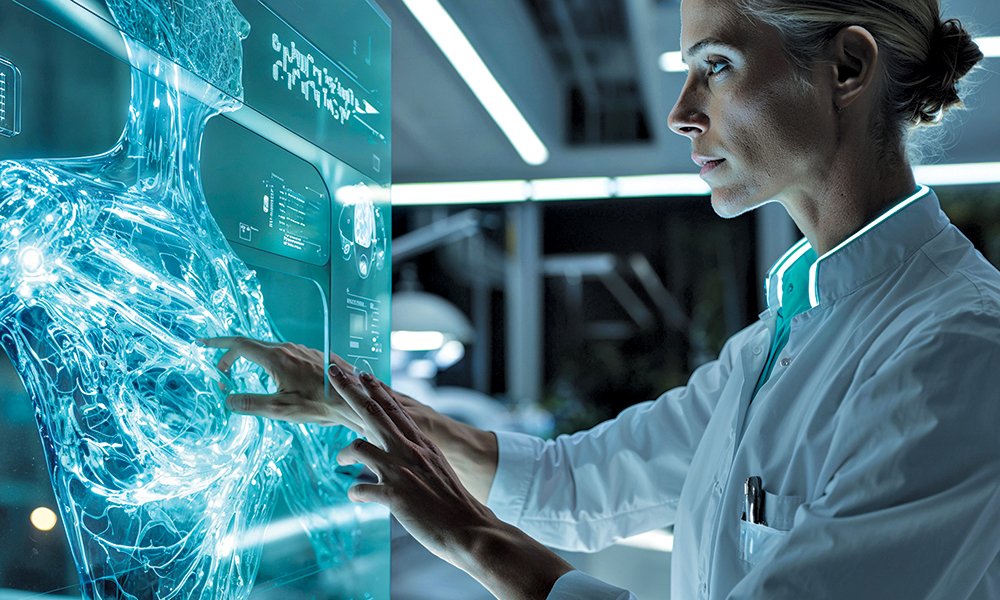When envisioning the future, it’s difficult not to picture a world dominated by autonomous robots. However, the latest technologies that promise peak safety for breast surgery and augmentation patients may surprise you. While AI-powered robotic surgeries are considered the next big advancement in many medical fields, they actually add more time and cost to breast procedures, according to Denver plastic surgeon Philippe A. Capraro, MD.
Wearable technology and microchips designed to monitor patient health and breast implants are also in development, but are still in the early stages. “While not a substitute for clinical care, wearable monitoring could provide personalized, data-driven recovery guided by real-time insights,” says Southfield, MI plastic surgeon Mariam Awada, MD. Similarly, chips that can detect implant ruptures could be particularly beneficial for those with silicone implants. “Most silicone implants are gel-filled, making it difficult to determine if an implant is damaged,” adds Dr. Capraro. So, which technologies show the most promise for enhancing patient safety? It’s a combination of familiar and innovative approaches that offer the potential for more natural-looking results than ever before.
Tracking + Traceability: Advanced Registries
For years, individuals who received breast implants have been part of a registry that includes information such as implant type, manufacturer, and batch number. This data is essential for cross-referencing against recalls, addressing complications, or planning future appointments. However, this information is easily lost if a surgeon retires, cards are misplaced, or the manufacturer is forgotten.
To address this, companies are working on digitizing record-keeping. One approach is to embed RFID tags in the implants themselves, as Motiva has done with its Ergonomix2 implant (not yet approved in the US). Similar to tracking technology for pets, these tags are programmed with identifying details like implant style, volume, and manufacturing date. Eugene, OR plastic surgeon Mark Jewell, MD, sees the technology as potentially useful, but raises concerns about potential hacking and patient data security. He believes that most patients have their implant information in a secure registry.
Some experts, like Sea Girt, NJ plastic surgeon Caroline Glicksman, MD, highlight concerns about the impact of these tags on MRI imaging quality. Instead, they advocate for data registries like the National Breast Implant Registry (NBIR) as a secure way to store implant identification information. These registries, such as the American Registry for Breast Implant Surveillance (ARISE) by The Aesthetic Society, offer secure storage of implant information and operation reports for easy access in case of emergencies or follow-up care.
Imagine breast enhancement or reconstruction where the final result is your own natural tissue.
Dr. Mariam Awada
The No-Implant Implant
Advancements in techniques, tools, and aesthetic trends are making breast surgeries less detectable. Medtech companies are now developing implants designed to eventually disappear.
Regenerative and aesthetic medicine firms like CollPlant Biotechnologies and BellaSeno are creating 3D-printed implants that promote natural breast tissue growth and degrade over time. BellaSeno’s resorbable breast scaffolds, for example, are inserted into the body and populated with the patient’s own fat to achieve a natural appearance. However, questions remain about long-term results, the impact on mammograms, and potential complications from scaffold degradation.
While these advancements show promise for breast augmentation and reconstruction, further research is needed to ensure patient safety and optimal outcomes.
The introduction of 3D-printed, absorbable breast forms has revolutionized the way surgeons plan for surgery based on patient measurements and tissue characteristics, similar to planning a breast augmentation. The customization offered by 3D printing technology has the potential to make future breast augmentations the most natural-looking yet.
Dr. Singer believes that we are on the verge of a breakthrough where disappearing implants could be replaced with natural tissue. This advancement could eliminate complications like ruptures or capsular contracture, providing patients with more natural and safer results.
Dr. Awada sees regenerative medicine as a game-changer in breast enhancement and reconstruction. With dissolvable 3D scaffolds and intelligent post-op care, patients could see their own natural tissue gradually grow, reducing implant-related risks and the need for reoperations. This personalized approach offers a safer and smarter future for breast surgeries.
The use of AI technologies in post-surgery predictions is changing the game for aesthetic medicine. Surgeons can now use tools like Natrelle 3D Visualizer, Crisalix, and Vectra XT to create lifelike simulations and predictive analytics for patients. This not only helps patients visualize potential results but also allows surgeons to explain the surgical process more effectively, managing expectations and ensuring patient satisfaction.
In-house ultrasound monitoring is another innovative approach being adopted by breast augmentation specialists. Instead of relying on expensive MRIs for post-op monitoring, surgeons can now use ultrasound machines in their offices to evaluate recovery and progress. This technology not only improves patient safety but also allows for early detection of complications, making surgeries safer and more effective.
The future of breast surgeries is evolving with the integration of 3D printing, AI technologies, and ultrasound monitoring. These advancements promise a more personalized, natural, and safer approach to breast enhancements and reconstructions, setting a new standard for the industry.

